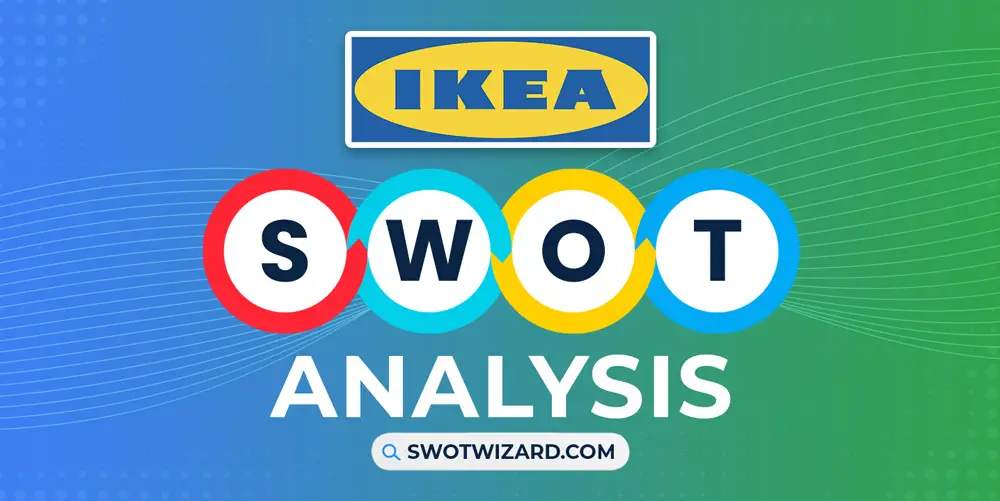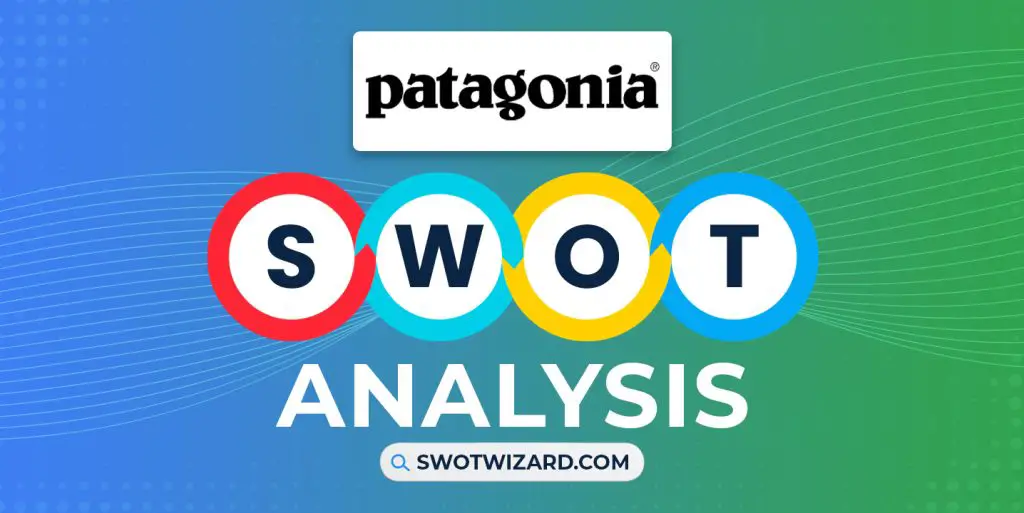IKEA revolutionized the furniture market with its ready-to-assemble products and took the market by storm. The company is still holding a leading position in the market, but has lost its past dominance. To understand how a simple business decision can cut costs and earn a company’s market leadership, let’s go through the IKEA SWOT analysis.
IKEA: Company Overview
| Company | IKEA International Group |
| Industry | Retail |
| Founded | 28 July, 1943 |
| Founder | Ingvar Kamprad |
| CEO | Jon Abrahamsson Ring |
| Headquarter | Netherlands |
| No. of Employees | 231,000+ |
| Annual Revenue | €41.9 billion (FY 2021) |
| Website | ikea.com |
IKEA was founded by Ingvar Kamprad as a boy, using money gifted by his father in 1943. The company first started selling furniture in 1948 but was forcefully shut down in Sweden by the 1950s. Yet, the company persisted and opened its 1st flagship store outside of Stockholm in 1965.
Now, IKEA is a multinational conglomerate that has expanded beyond furniture. The company’s headquarters is in Delft, Netherlands. In 2022, it generated a revenue of $30 million and had 231,000 employees.
Product & Services of IKEA
Furniture | Kitchen & Appliances | Kitchen & Tableware | Textiles | Bathroom Products | Beds & Mattresses | Outdoor Products | Lighting | Decoration
IKEA Competitors
Wayfair | Target | Walmart | Ashley Furniture | Crate & Barrel | Pottery Barn | Overstock | Cost Plus World MarketTesla
Did You Know?
IKEA comes from Ingvar Kamprad’s initials, Elmtaryd and Agunnaryd, the farm and the village where he grew up.
Strengths – IKEA SWOT Analysis

Monolithic Size: IKEA will be the world’s 3rd largest furniture retailer in 2023, with 460 stores operating in 62 markets across the world. It’s especially dominant in the European region, with 274 stores in the market, followed by 93 in Asia. Customers visit IKEA stores over 822 million times per year, and the company’s website gets 4.3 billion visitors annually. With 14.2% of its sales coming from Germany and 13.4% coming from the US, IKEA’s sheer size allows it to stay relevant in the market and resist adverse external change drivers.
Wide Product Range: IKEA’s primary product line may be furniture, but the company goes beyond its already diverse selection to offer more products to its customers. The company also sells mattresses, bedding, bed slats, mattress bases, bags, wall hooks, ovens, dishwashers, refrigerators, and 27 other categories of products. And on the furniture side, IKEA sells over 20 categories of products, including beds, chairs, desks, armoires, wardrobes, and bookcases.
Unique Business Models: IKEA deploys 2 business models that are unique within the furniture industry. Its primary or physical business is based on the franchising model, where IKEA makes money by charging 3% of net sales annually and wholesaling the brand’s products to its franchisees. Its secondary business is direct selling to customers through its virtual platform, and IKEA generated over $11.230 million through selling directly in 2021. Franchising allows the company to expand faster than its competitors, while selling online allows the company to reach customers that are unreachable through its physical outlets.
Offering Quality And Value: IKEA snitches most customers away from its competitors by offering similar or higher quality furniture at lower prices. IKEA can achieve this by allowing the customers to take away parts and assemble the furniture themselves. By shoving the assembly on the shoulders of the customers, IKEA avoids additional labor costs, which can take up to 25-35% of its gross sales away. IKEA can increase its profits more than its competitors by extending sales volume and lowering production costs through this strategy.
Compelling Designs: Unlike most franchises, IKEA does not push generic product designs repeatedly. The company’s designer team members are allowed to fully exercise their ideas and philosophies in their designs and come up with uniquely designed products that don’t mesh with each other. IKEA’s freedom in design creates a diverse set of product designs that can appeal to a broader customer base. The designers can practice their creativity without restriction to produce innovative designs which become icons in the furniture market and improve IKEA’s image.
Weaknesses – IKEA SWOT Analysis
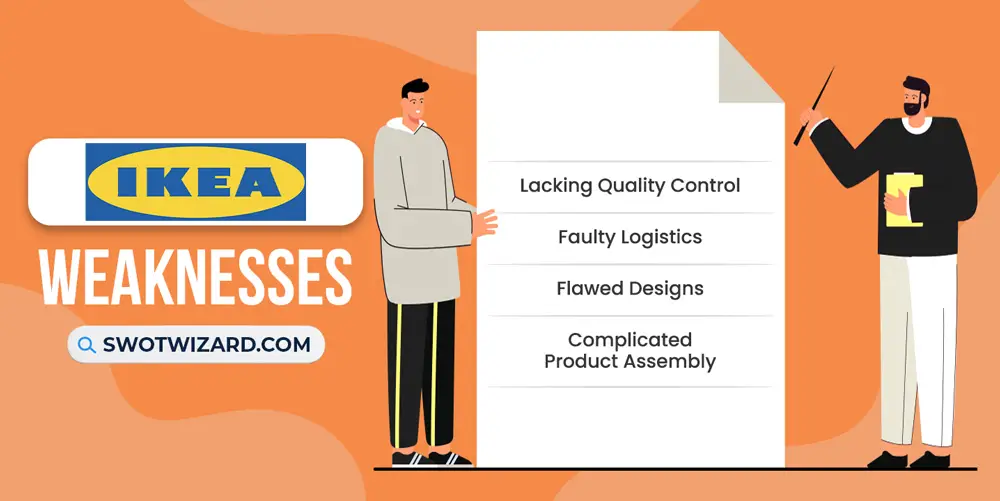
Lacking Quality Control: Unfortunately, IKEA’s products are often found to have operational issues or broken before a reasonable amount of time. Customers have complained of furniture breaking too soon, products shipped with missing pieces, and not functioning as intended. Some products have inherent design flaws that have caused accidents, such as the Lurvig water dispenser killing 2 dogs whose heads got stuck as they tried to drink. Another nefarious product was the Calypso lamp, which had its frosted glass shade randomly detached from the steel base, risking severe injuries from impact or laceration from shards.
Faulty Logistics: IKEA has caused many customers undue frustration from slow shipments and missing deliveries. The company has had numerous complaints registered from customers who have received their packages much later than the given date and many who have not received their packages. Some customers had been told that their order was confirmed. But later, they were informed about the cancellation via automated messages and calls. The issue reached a peak during the pandemic when IKEA had a scarcity of drivers and raw material shortages, but it persists to date.
Flawed Designs: IKEA’s drive to create uniquely designed products sometimes causes its product to have fatal flaws that cannot be repaired. For example, IKEA’s Heroisk and Talrika bowls have melted and leaked out hot food on people, and the Troligtvis travel mug caused toxic chemicals to seep into any liquid put in it. A bigger failure happened in 2018 when the majority of Sladda bike users had their belt drive broken at random, and IKEA could only issue a full product line refund. However, the biggest design failure was the mid-80s a.i.r sofa, which melted, squeaked, moved around, and caused discomfort when sat on.
Complicated Product Assembly: IKEA has failed to communicate how to assemble its furniture. Many frustrated customers have failed to understand the wordless instructions provided in the manual, while many of the small parts kept getting lost. As IKEA’s furniture kits come with no replacement, if customers lose anything, they are unable to assemble their product. Most customers purchase IKEA furniture for the price and value it provides, yet a large portion of those customers ultimately have to resort to spending more for hiring experts to assemble the furniture for them.
Opportunities – IKEA SWOT Analysis

Locally Sourcing For The Indian Market: IKEA’s Indian customers have shown a preference to lower prices and pre-assembled furniture. To lower costs, IKEA can locally source the raw material and workforce to manufacture its internationally available designs.
Using VR And AR: IKEA can integrate virtual reality and augmented reality into its mobile app. With virtual reality, customers can put in customer parameters to roughly simulate an empty room and fill it with IKEA furniture and items to see if they like the whole setup. And they can check out if the furniture they’re interested in is the perfect one by using augmented reality to place it in their room.
Refining Last-mile Delivery: IKEA can contract local logistics companies for its international markets’ last-mile delivery. The company can avoid late shipping and other issues by connecting the customer with their contracted company and leaving the responsibility of handling the product to them.
Threats – IKEA SWOT Analysis
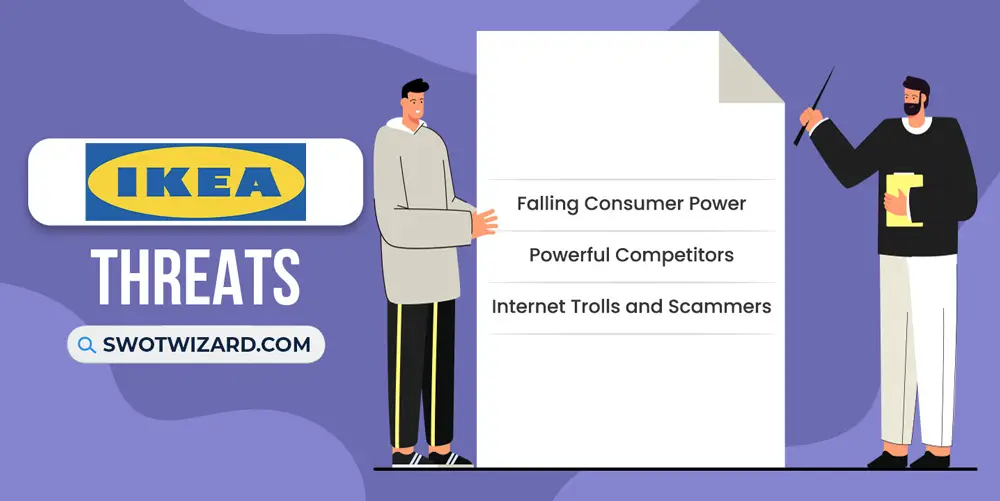
Falling Consumer Power: The consumer purchasing power has been reducing across the globe drastically, and it shows no signs of improving. In the US, consumer purchasing power has been reducing by an average rate of 3.08%, and it fell by 5.68% from 2022. By 2030, Germany and US will have recovered very little in terms of purchasing power, while France has been on a downward trend since 2014. These 3 are IKEA’s biggest markets, and if consumers cannot buy its products here, it will experience a significant loss of revenue.
Powerful Competitors: The furniture market is oversaturated with powerful competitors and may have unique business models or product offerings that rival that of IKEA. For example, Wayfair has been contending with IKEA in the US, and it has an advantage due to the dominance of its virtual platform, over 10 million products, and 10,000 suppliers. Similarly, Amazon, Ashley HomeStore, Walmart, Home Depot, and other monolithic companies are easily capable of taking IKEA’s market share away with their powerful supply chains and market presence.
Internet Trolls and Scammers: IKEA has become a victim of internet pranks by trolls, and its image has been tarnished by scammers. Internet trolls such as comedian Jeff Wysaski leave low ratings and bad reviews on products on purpose, creating confusion and bad impressions within its customer base. Also, online scammers often retail fake IKEA products by opening counterfeit websites or retail outlets, which ruins IKEA’s brand name and reliability. With enough pranks and scams, IKEA’s reputation can be called into question by customers, and they may avoid the company as a result.
[Bonus Infographic] SWOT Analysis of IKEA
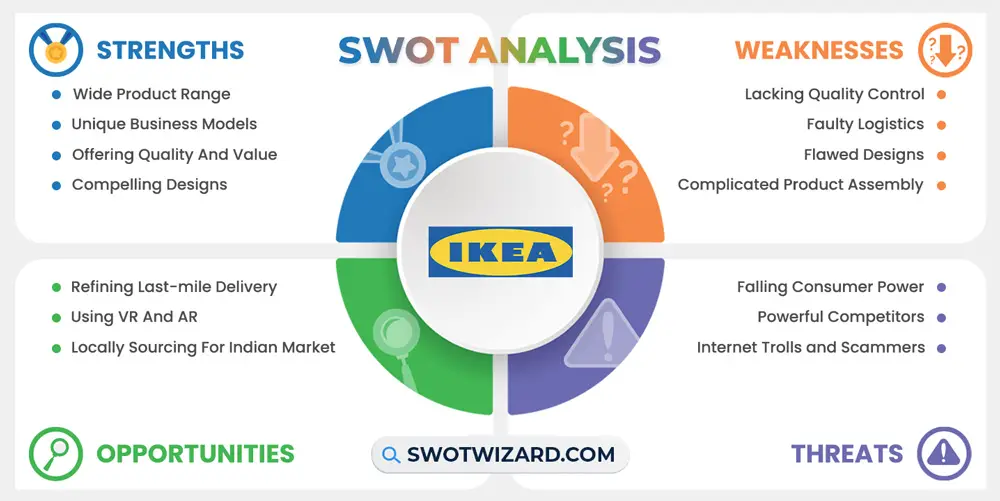
Recommendations for IKEA
IKEA can consider these improvements to hold onto its market share.
- IKEA should include proper wording in its assembly instructions.
- The company could provide PDFs of the instruction manual on its website.
- IKEA can use local workforces and resources in international markets.
- The company should thoroughly test its products before launch.
- IKEA should use public surveys to verify its aggressively designed products.
Frequently Asked Questions (FAQs)
How does IKEA get customers to spend more?
IKEA used the Gruen Effect and make customers more prone to impulse purchases.
Where is the largest IKEA store?
IKEA’s largest store is in Pasay City, and it’s larger than 150 basketball courts.
Final Words on IKEA SWOT Analysis
IKEA is a monolith that has led the furniture industry through its ingenious business strategies, value, and design. However, its tactics are no longer viable in an oversaturated, competitive market. To claim its market share, the company must rework its customer experience, product quality, and logistics.
References
- Wikipedia contributors. (n.d.). IKEA. Wikipedia.
- D. (n.d.). Guy Trolls IKEA By Putting Fake In-Store Reviews All Over The Place. Bored Panda.
- Beware of fake Ikea websites: Over 700 Filipinos fall victim to scams. (2023, March 5). Bilyonaryo.
- DIAZ, J. (2018, September 28). Ikea recalls Calypso lamps that pose “laceration hazards.” Fast Company.
- The history of the IKEA brand at a glance. (n.d.). IKEA.
- Matarese, J. (2020, August 25). IKEA customers complain of long delivery delays. WCPO 9 News.
- Ikea’s bike was good–but now they’re all being recalled. (2018, June 5). Fast Company.
- Ikea warns supply chain disruptions are likely to last into 2022. (2021, October 14). CNBC.

